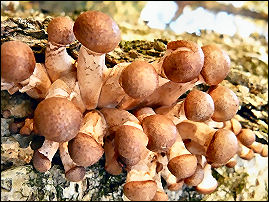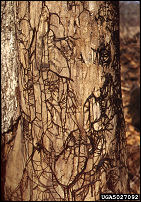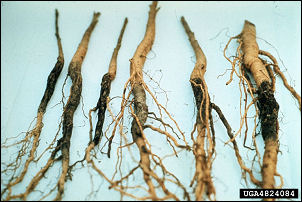|
|
![]()
FOREST HEALTH - HARDWOOD ROOT DISEASES
Roots are vulnerable to many soil borne fungi especially when trees are weakened by drought, insect attack, and other stess agents. Usually root diseases are not easily seen, as roots are underground. The above-ground symptoms are noticed and sometimes not connected with root disease. Root disease can affect a seemingly random individual tree, or can kill entire areas (especially in plantation environments). Of course, it's important to remember that many soil fungi are beneficial to trees. Those that develop symbiotic relationships with roots are called mycorrhizae. Some mychorrhizae are essential to tree health and vigor.
| Armillaria Cylindrocladium |
||
| Armillaria (Armillaria mellea et al.): a very common soil fungus that invades stressed and dead trees, usually considered a root rot, sometimes called 'shoestring rot' after the strands of fungal tissue under dried-out bark, edible fruiting bodies sometimes called 'honey mushrooms', this is the 'humungous fungus' of Crystal Falls, can be responsible for mortality of individual trees within plantations | ||
| Hosts: most tree species | ||
  |
||
Cylindrocladium (Cylindrocladium spp.): more a problem in nurseries than in the wild, generally affects conifers more than hardwoods, blackens roots and causes top death |
||
| Hosts: oaks, walnut, possibly others | ||
 |
||
Image Citations
Armillaria (2) - Joseph O'Brien, USDA Forest Service, Bugwood.org
Clyindrocladium (1) - Edward L. Barnard, Florida Department of Agriculture and Consumer Services, Bugwood.org
All others - Bill Cook, Michigan State University Extension
Click HERE
to return to the U.P. Tree ID home page.
Click HERE to return to the Forest Health home page.
This site created and maintained by Bill Cook, MSU Extension Forester for the Upper Peninsula of Michigan. Editing and modification is ongoing. Submit suggestions, questions, and corrections to cookwi@msu.edu or call 906-786-1575.